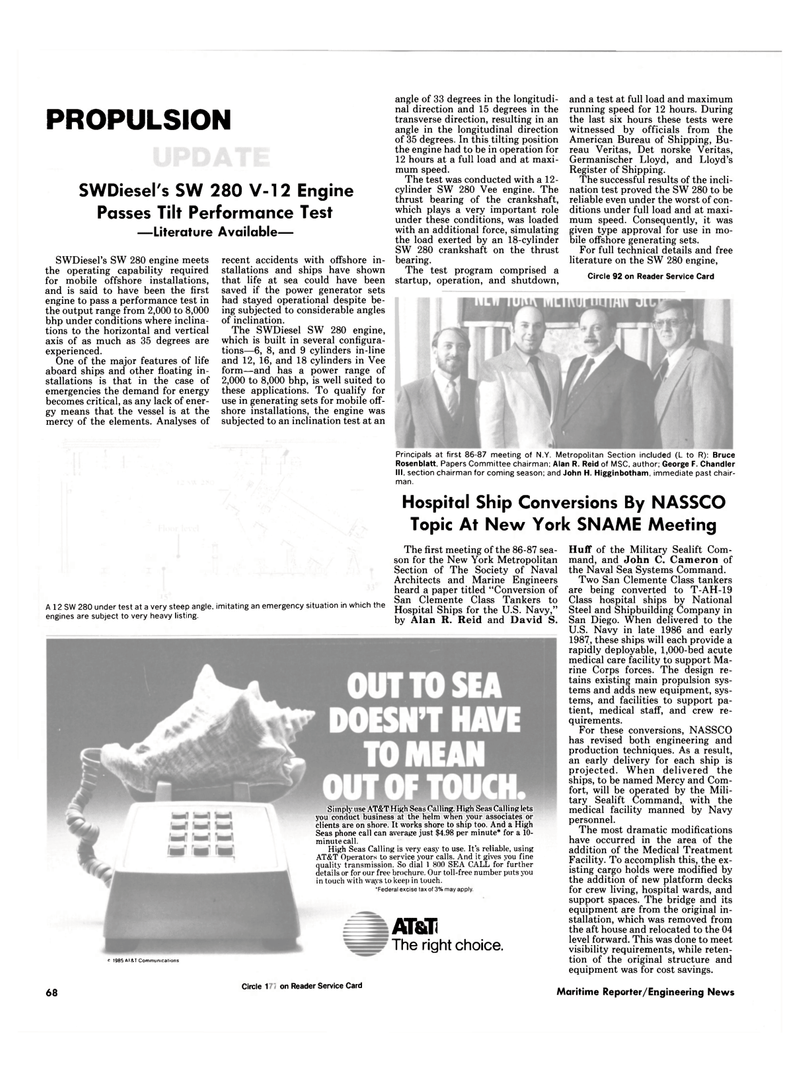
Page 64: of Maritime Reporter Magazine (November 1986)
Read this page in Pdf, Flash or Html5 edition of November 1986 Maritime Reporter Magazine
PROPULSION
SWDiesel's SW 280 V-12 Engine
Passes Tilt Performance Test —Literature Available—
SWDiesel's SW 280 engine meets the operating capability required for mobile offshore installations, and is said to have been the first engine to pass a performance test in the output range from 2,000 to 8,000 bhp under conditions where inclina- tions to the horizontal and vertical axis of as much as 35 degrees are experienced.
One of the major features of life aboard ships and other floating in- stallations is that in the case of emergencies the demand for energy becomes critical, as any lack of ener- gy means that the vessel is at the mercy of the elements. Analyses of recent accidents with offshore in- stallations and ships have shown that life at sea could have been saved if the power generator sets had stayed operational despite be- ing subjected to considerable angles of inclination.
The SWDiesel SW 280 engine, which is built in several configura- tions—6, 8, and 9 cylinders in-line and 12, 16, and 18 cylinders in Vee form—and has a power range of 2,000 to 8,000 bhp, is well suited to these applications. To qualify for use in generating sets for mobile off- shore installations, the engine was subjected to an inclination test at an angle of 33 degrees in the longitudi- nal direction and 15 degrees in the transverse direction, resulting in an angle in the longitudinal direction of 35 degrees. In this tilting position the engine had to be in operation for 12 hours at a full load and at maxi- mum speed.
The test was conducted with a 12- cylinder SW 280 Vee engine. The thrust bearing of the crankshaft, which plays a very important role under these conditions, was loaded with an additional force, simulating the load exerted by an 18-cylinder
SW 280 crankshaft on the thrust bearing.
The test program comprised a startup, operation, and shutdown, and a test at full load and maximum running speed for 12 hours. During the last six hours these tests were witnessed by officials from the
American Bureau of Shipping, Bu- reau Veritas, Det norske Veritas,
Germanischer Lloyd, and Lloyd's
Register of Shipping.
The successful results of the incli- nation test proved the SW 280 to be reliable even under the worst of con- ditions under full load and at maxi- mum speed. Consequently, it was given type approval for use in mo- bile offshore generating sets.
For full technical details and free literature on the SW 280 engine,
Circle 92 on Reader Service Card
Principals at first 86-87 meeting of N.Y. Metropolitan Section included (L to R): Bruce
Rosenblatt, Papers Committee chairman; Alan R. Reid of MSC, author; George F. Chandler
III, section chairman for coming season; and John H. Higginbotham. immediate past chair- man.
Hospital Ship Conversions By NASSCO
Topic At New York SNAME Meeting
A 12 SW 280 under test at a very steep angle, imitating an emergency situation in which the engines are subject to very heavy listing.
The first meeting of the 86-87 sea- son for the New York Metropolitan
Section of The Society of Naval
Architects and Marine Engineers heard a paper titled "Conversion of
San Clemente Class Tankers to
Hospital Ships for the U.S. Navy," by Alan R. Reid and David S.
Simply use AT&T High Seas Calling. High Seas Calling lets you conduct business at the helm when your associates or clients are on shore. It works shore to ship too. And a High
Seas phone call can average just $4.98 per minute* for a 10- minutecall.
High Seas Calling is very easy to use. It's reliable, using
AT&T Operators to service your calls. And it gives you fine quality transmission. So dial 1 800 SEA CALL for further details or for our free brochure. Our toll-free number puts you in touch with ways to keep in touch. •Federal excise tax of 3% may apply.
AT&T
The right choice.
C) 1985 AT&T Communications 68 Circle 158 on Reader Service Card
Huff of the Military Sealift Com- mand, and John C. Cameron of the Naval Sea Systems Command.
Two San Clemente Class tankers are being converted to T-AH-19
Class hospital ships by National
Steel and Shipbuilding Company in
San Diego. When delivered to the
U.S. Navy in late 1986 and early 1987, these ships will each provide a rapidly deployable, 1,000-bed acute medical care facility to support Ma- rine Corps forces. The design re- tains existing main propulsion sys- tems and adds new equipment, sys- tems, and facilities to support pa- tient, medical staff, and crew re- quirements.
For these conversions, NASSCO has revised both engineering and production techniques. As a result, an early delivery for each ship is projected. When delivered the ships, to be named Mercy and Com- fort, will be operated by the Mili- tary Sealift Command, with the medical facility manned by Navy personnel.
The most dramatic modifications have occurred in the area of the addition of the Medical Treatment
Facility. To accomplish this, the ex- isting cargo holds were modified by the addition of new platform decks for crew living, hospital wards, and support spaces. The bridge and its equipment are from the original in- stallation, which was removed from the aft house and relocated to the 04 level forward. This was done to meet visibility requirements, while reten- tion of the original structure and equipment was for cost savings.
Maritime Reporter/Engineering News

 63
63

 65
65
